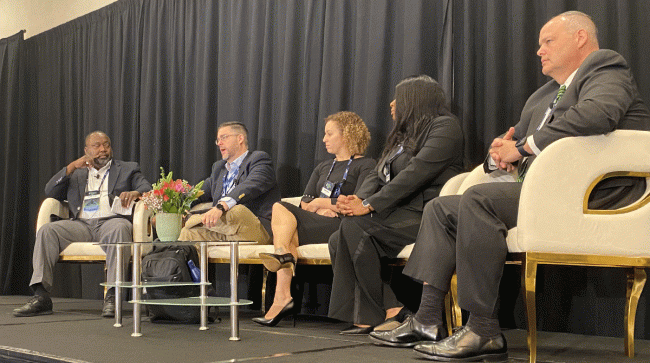Staff Reporter
How Trucking Can Fight Back Against Cyberthreats

[Stay on top of transportation news: Get TTNews in your inbox.]
HOUSTON — The trucking industry faces an increasingly dangerous and complex cybersecurity landscape, but there are ways to counter the threats, according to experts.
“I think that the APTs, the Advanced Persistent Threats, will become more stealthy, harder to detect,” U.S. Secret Service Agent Clarke Skoby said Oct. 24. “I also think that criminals will learn to use AI to further their criminal endeavors. AI is a disruptive technology; it’s going to make our lives easier, write speeches for us, things like that. But also, it’s a two-edged sword where criminals are going to use AI.”
Skoby added that security companies also will be able to use AI to better detect malware on their systems. He also expressed concern over cryptocurrency fraud. He believes cryptocurrency can be a secure way to transfer funds, but warns criminals are using the technology, too.
“My prediction is that it’s going to just continue to get more sophisticated,” said Takeda Parker-Bradford, a compliance administrator at the Transportation Security Administration. “Some of the tactics that we see constantly, like phishing, we’ve discussed the ways that we were able to defend against them before, teach our people to defend against them before, may not be as apparent as it used to be. It’s going to get more and more complex.”

Parker-Bradford
Parker-Bradford also pointed to deepfake technology as another potential method criminals can use to scam people. The technology utilizes deep-learning methods to create manipulated digital media that replaces someone’s likeness with that of another person. Parker-Bradford warned criminals could use this technology in their attacks by pretending to be someone else, including better understanding nonverbal communication methods such as mannerisms and habits.
“Those type of signature-based things may now be more difficult to detect utilizing scanners and machine-learning devices,” Parker-Bradford said. “I think there’s going to be more of an emphasis from an attack perspective to pollute some of the technologies that we have as far as our defenses. So, I don’t know how we guard against that at this point. But I think that’s something that we should definitely have on our radar.”
The National Motor Freight Traffic Association hosted the discussion as part of its Digital Solutions Conference. The two-day event brought together transportation and cybersecurity experts to identify issues and talk about best practices.

Thomas
“With regard to the tactics around social engineering, obviously with AI and making them more realistic, and then also just with the evolving privacy regulations, I think we’re going to continue to see that evolve, especially with AI and what that looks like,” said Shelly Thomas, senior vice president at risk management firm Marsh. “I don’t think anyone really knows exactly what that looks like, but just in regard to copyright infringements, I think we may see more around that with regards to AI.”
Thomas recommended that companies consider getting cybersecurity insurance. She noted that they should be checking vendor contractual requirements to ensure that they’re meeting requirements from a cybersecurity insurance perspective. She has been seeing a lot of contracts requiring higher limits.

Gardiner
“My focus being mainly on assets that roll the trucks, I think that we need a way to segment telematics devices from vehicle networks, especially on older trucks,” said Ben Gardiner, senior cybersecurity research engineer contractor at NMFTA. “But short of that, I think fleets need to have contractual guarantees for cybersecurity in the telematics devices that they purchase so that they know that the telematics devices that they’re installing are secure. The third one is, obviously, awareness training.”
Clarke echoed the importance of awareness training while noting that educating employees about cybersecurity threats will help tremendously. He also recommended that companies have a solid incident response plan that they test and update regularly.
Volvo's Keith Brandis and Eric Bond take an in-depth look at how the company's SuperTruck 2 improves freight efficiency. Tune in above or by going to RoadSigns.ttnews.com.
“Backups are the key to bounce back from ransomware, and all of the ransomware incidents that I’ve been called out to where they actually did have backups, they were on the network and they got encrypted too,” Clarke said. “So, once you get that backup, remove it from the network, put it someplace safe.”
Parker-Bradford also stressed the importance of ensuring cybersecurity plans and personnel are being tested. She also recommended companies find communities, like an intelligence stream, of people who all have similar cybersecurity objectives such as securing mass transit.
“With the federal government, I know you guys love us, love to hate us sometimes as well, but we all have one common goal,” Parker-Bradford said. “That’s just to ensure that the protections that we put into place, not only are implemented, but they’re maintainable, they’re repeatable, they’re things that will actually be able to evolve along with you as you scale.”
Want more news? Listen to today's daily briefing below or go here for more info:





